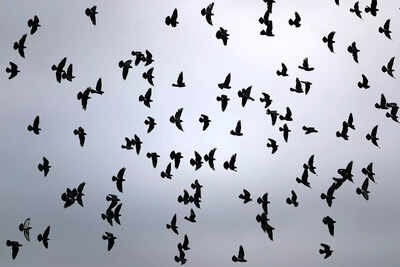Top Searches
- News
- India News
- First bird flu death at AIIMS in India: All you want to know about influenza virus
First bird flu death at AIIMS in India: All you want to know about influenza virus

File photo for representation purpose only
NEW DELHI: India has reported the first case of human death due to bird flu, the strain of influenza virus that primarily affects birds.
An 11-year-old boy, admitted to AIIMS on July 2, was confirmed dead due to bird flu on Tuesday. Contact tracing to identify people who might have been in close proximity with the boy is being undertaken.
Here is all you want to know about Bird flu or Avian influenza:
An 11-year-old boy, admitted to AIIMS on July 2, was confirmed dead due to bird flu on Tuesday. Contact tracing to identify people who might have been in close proximity with the boy is being undertaken.
Here is all you want to know about Bird flu or Avian influenza:
- WHAT IS BIRD FLU OR
AVIAN INFLUENZA
Not all avian influenza viruses can affect humans. However, some can cause severe disease in them. Avian influenza H5N8 virus, commonly known as bird flu, is one of them. It attacks the lungs, nose and throat. It's a contagious respiratory illness and has symptoms similar to common cold
- SYMPTOMS
Initial stage: Sore throat, sneezing, runny nose
Later stage: Fever, muscle pain, body chills, sweating, headache, dry cough, nasal congestion, fatigue - HIGH-RISK GROUPS
Children under the age of 2 and adults over 65
Those with comorbidities
Women who are pregnant or have recently given birth
- HOW HUMANS MAY GET INFECTED
Person-to-person spread of bird flu is not common. Those who work in close contact with infected birds, dead or alive, or eat uncooked or half-cooked poultry products are at risk
- DIRECT CONTACT (MOST COMMON)
Human can get infected after touching infected bird and then touching their eyes, nose or mouth - CONTAMINATED SURFACES
A healthy looking bird can also spread the virus through its droppings on surfaces - VIRUS IN THE AIR
It may be in the air in the form of droplets or dust after an infected bird flaps its wings of shakes. Humans can get the virus if they inhale it
- BIRD-TO-BIRD TRANSMISSION
Some bird species like ducks and geese are considered to be natural reservoirs of influenza type-A virus. They can spread the disease through their droppings. - HOW TO STAY SAFE
Avoid exposure like coming in direct or close contact with infected poultry Avoid consumingCooking at uncooked or partially high heat kills cooked chicken and eggs Cooking at high heat kills the virusIf in direct contact with birds, influenza antiviral drugs can be taken as a preventive measure
FacebookTwitterLinkedinEMail
Start a Conversation
end of article
Quick Links
Coronavirus in MumbaiFarm bill 2020Farmers protestCoronavirus in DelhiCoronavirus in BangaloreCoronavirus symptomsCoronavirus in IndiaWest Bengal elections 2021Coronavirus NewsSolar EclipseNPRWhat is NRCCAB BillCAB and NRCAssam election 2021Podcast newsLok SabhaTamil Nadu Election 2021CongressBJP newsKerala Elections 2021Indian ArmyISRO newsSupreme Court

